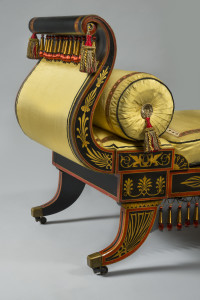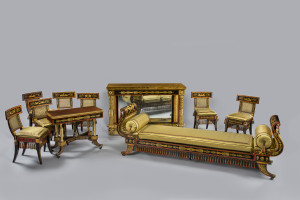Classical Splendor at the PMA
As part of a series of exhibitions celebrating great American art, the Philadelphia Museum of Art will mount the much-anticipated show on painted furniture made in Philadelphia in 1808. Classical Splendor: Painted Furniture for a Grand Philadelphia House will open in early September 2016 and focus on the set of painted and gilded furniture produced for merchant William Waln and his wife, Mary Wilcocks Waln. Co-curated by Alexandra Kirtley, Trust Governor and the PMA’s Montgomery-Garvan Curator of American Decorative Arts and Conservator Peggy Olley, the project will detail the intricacies of the furniture commission, the Walns’ house for which it was made, and the architect, cabinetmaker, decorative artist, and upholsterer involved in producing it.
In 1808, architect B. Henry Latrobe oversaw the completion of his design for the Walns’ house. The exterior epitomized the restrained aesthetic of Latrobe’s residences, while the interior featured an elaborate scheme for the two drawing rooms that served as the house’s centerpiece. Latrobe designed the interiors to embody the knowledge, refinement, and aspirations of its owners. For the walls, Latrobe instructed British decorative artist George Bridport to paint the frieze of these lofty rooms in the Etruscan style, a de rigeurapproach in contemporary European houses as observed in several late-18th and early-19th-century Sicilianpalazzi during the Trust’s recent tour (see review).
For the furniture, Latrobe took his cue from the classicism promoted by French designers Charles Percier and Pierre F.L. Fontaine and widely admired by Mary Waln, who was Latrobe’s enthusiastic collaborator in the project. The severe klismos-form chairs referenced furniture of the Greeks and Romans; the painted decoration in a black, red, yellow, and gold palette evoked the painted decorations found on ancient pottery and wall paintings; and the upholstery combined the finest materials and elements available to embellish and soften the furniture. The furniture and furnishings served as important vehicles in the social theatre of the Walns’ drawing rooms and, moreover, in the swirl of early-19th-century Philadelphia.
As the house was demolished in 1847, the furniture remains the only suggestion of one of Philadelphia’s most celebrated interiors. Now, after years of investigation, the impact of this furniture—starting with Latrobe’s design for the Madison White House in 1809 (made by the Finlay brothers of Baltimore)—can be understood fully as a powerful tool of influence in early-19th-century America. The exhibition will convey the significance of the furniture’s design, creation, use, history, and recent conservation treatment, and place it in the landscape of early-national America.
The catalogue by Kirtley and Olley will include an essay by architectural historian and Latrobe scholar Professor Jeffrey Cohen of Bryn Mawr College, who will situate the Walns’ house within the architectural landscape of early national Philadelphia. Kirtley and Olley will address the furniture and its commission and the makers, emphasizing the painted work of Bridport, much of which was been re-evaluated during a conservation treatment from 2010 to 2015. Catalogue entries on the Museum’s 11 pieces of Waln furniture will include commentary from the Museum’s seamstress, Elizabeth Paolini, on its upholstery.
N.B. The Trust will have the pleasure of collaborating with the PMA’s Center for American Art on a one-day symposium organized in conjunction with Classical Splendor. Stay tuned for more information!
SAVE THE DATE
- Special Symposium
“Classical Splendor”
The Philadelphia Museum of Art
November 4, 2016 - New York Antiques Weekend
January 20-21, 2017 - Spring Symposium
Savannah
April 21-24, 2017 - Spring Study Trip Abroad
Scotland
May 14-22, 2017 - Fall Symposium
Hartford & Western Connecticut
September 2017 - Fall Study Trip Abroad
Venice and the Veneto
October 9-16 and 22-29, 2017
As part of a series of exhibitions celebrating great American art, the Philadelphia Museum of Art will mount the much-anticipated show on painted furniture made in Philadelphia in 1808. Classical Splendor: Painted Furniture for a Grand Philadelphia House will open in early September 2016 and focus on the set of painted and gilded furniture produced for merchant William Waln and his wife, Mary Wilcocks Waln. Co-curated by Alexandra Kirtley, Trust Governor and the PMA’s Montgomery-Garvan Curator of American Decorative Arts and Conservator Peggy Olley, the project will detail the intricacies of the furniture commission, the Walns’ house for which it was made, and the architect, cabinetmaker, decorative artist, and upholsterer involved in producing it.
In 1808, architect B. Henry Latrobe oversaw the completion of his design for the Walns’ house. The exterior epitomized the restrained aesthetic of Latrobe’s residences, while the interior featured an elaborate scheme for the two drawing rooms that served as the house’s centerpiece. Latrobe designed the interiors to embody the knowledge, refinement, and aspirations of its owners. For the walls, Latrobe instructed British decorative artist George Bridport to paint the frieze of these lofty rooms in the Etruscan style, a de rigeurapproach in contemporary European houses as observed in several late-18th and early-19th-century Sicilianpalazzi during the Trust’s recent tour (see review).
For the furniture, Latrobe took his cue from the classicism promoted by French designers Charles Percier and Pierre F.L. Fontaine and widely admired by Mary Waln, who was Latrobe’s enthusiastic collaborator in the project. The severe klismos-form chairs referenced furniture of the Greeks and Romans; the painted decoration in a black, red, yellow, and gold palette evoked the painted decorations found on ancient pottery and wall paintings; and the upholstery combined the finest materials and elements available to embellish and soften the furniture. The furniture and furnishings served as important vehicles in the social theatre of the Walns’ drawing rooms and, moreover, in the swirl of early-19th-century Philadelphia.
As the house was demolished in 1847, the furniture remains the only suggestion of one of Philadelphia’s most celebrated interiors. Now, after years of investigation, the impact of this furniture—starting with Latrobe’s design for the Madison White House in 1809 (made by the Finlay brothers of Baltimore)—can be understood fully as a powerful tool of influence in early-19th-century America. The exhibition will convey the significance of the furniture’s design, creation, use, history, and recent conservation treatment, and place it in the landscape of early-national America.
The catalogue by Kirtley and Olley will include an essay by architectural historian and Latrobe scholar Professor Jeffrey Cohen of Bryn Mawr College, who will situate the Walns’ house within the architectural landscape of early national Philadelphia. Kirtley and Olley will address the furniture and its commission and the makers, emphasizing the painted work of Bridport, much of which was been re-evaluated during a conservation treatment from 2010 to 2015. Catalogue entries on the Museum’s 11 pieces of Waln furniture will include commentary from the Museum’s seamstress, Elizabeth Paolini, on its upholstery.
N.B. The Trust will have the pleasure of collaborating with the PMA’s Center for American Art on a one-day symposium organized in conjunction with Classical Splendor. Stay tuned for more information!


